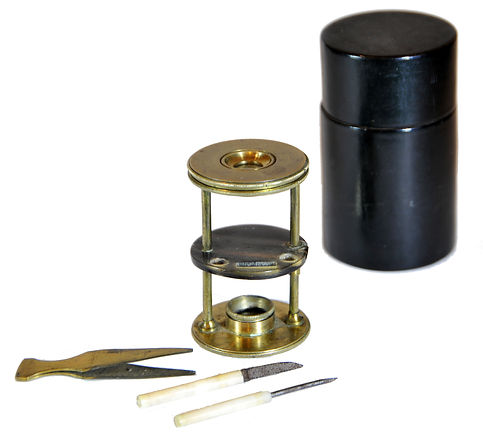

Withering-type botanical microscope, 1780
The “Withering-type Microscope” is named for its inventor, Dr. William Withering (1741-1799), an English physician and botanist who graduated with a degree in medicine 1766 in Edinburgh. Inspired by the taxonomical work and systematic classification of Carl Linnæus (1707-1778), Withering (1776) applied the Linnaean taxonomical system of classification to British plants in a seminal, two volume work, A Botanical arrangement of all the vegetables naturally growing in the British Isles. The earliest reference to a small botanical microscope of Withering’s design appeared in the first edition of this book. There, Withering indicated this microscope was developed for field dissections of flowers and other plant parts. While there is no surviving example of this exact design, close relatives of this type do exist, made either completely of brass or of ivory with brass pillars. Ivory models can be tentatively dated to 1776-1785, as by 1787 a newer model with a hollowed stage in an all-brass configuration already predominated. In turn, it was preceded by the brief appearance of a transitional brass model but with solid stage of ivory or horn (seen here). This version is extremely rare and must have been produced in very small numbers. By 1787 all these varieties were not recorded anymore in the literature.

Withering-type botanical microscope, 1780
The “Withering-type Microscope” is named for its inventor, Dr. William Withering (1741-1799), an English physician and botanist who graduated with a degree in medicine 1766 in Edinburgh. Inspired by the taxonomical work and systematic classification of Carl Linnæus (1707-1778), Withering (1776) applied the Linnaean taxonomical system of classification to British plants in a seminal, two volume work, A Botanical arrangement of all the vegetables naturally growing in the British Isles. The earliest reference to a small botanical microscope of Withering’s design appeared in the first edition of this book. There, Withering indicated this microscope was developed for field dissections of flowers and other plant parts. While there is no surviving example of this exact design, close relatives of this type do exist, made either completely of brass or of ivory with brass pillars. Ivory models can be tentatively dated to 1776-1785, as by 1787 a newer model with a hollowed stage in an all-brass configuration already predominated. In turn, it was preceded by the brief appearance of a transitional brass model but with solid stage of ivory or horn (seen here). This version is extremely rare and must have been produced in very small numbers. By 1787 all these varieties were not recorded anymore in the literature.
References: SML: A242712; Goren 2014.
References: SML: A242712; Goren 2014.
Prof. Yuval Goren's Collection of the History of the Microscope
Spike-Stand "flea glass" simple microscopes, ca. 1680-1750
These are early forms of the single microscope made of bone, horn, or fruitwood used in the Netherlands and the German lands over a vague period between the late 17th and mid-18th centuries. They have a single, biconvex lens mounted on the top of a stand facing a spike on a movable rod or a brass sprung pin, to which a flower or an insect could be speared for inspection (thus the term "flea glass", an English translation of the Latin name vitrum pulicarium). Focusing was achieved by moving the spike backwards or towards the lens.
A similar microscope appears in Johannes Zahn's (1702) book below.


Spike-stand microscope, after Zahn, Johan. 1702. Oculus artificialis teledioptricus sive telescopium. Nuremberg.
Flea, after Johann Franz Griendel. 1687. Micrographia nova sive Nova et curiosa variorum minutorum corporum... Nuremberg.
Bone and Horn Spike-Stand Microscopes, ca. late 17th century to ~1700
These are early Dutch forms of the spike-stand microscope lathe-turned of bone or horn. This early and relatively rare form of the Spike-Stand microscope is more or less similar to Zahn's depiction; the latter was probably turned of wood.


Inv. YG-21-002


Inv. YG-21-003
© Microscope History all rights reserved

Wood Spike-Stand, ca. 1700-1750
Inv. YG-20-002
This is a more common form of the Spike-Stand microscope, of a type that was probably related with an early stage of the manufacture of optical instruments by the wooden toy craftsmen of Bavaria (mostly Nuremberg), and the "Black Forest" areas of the German lands. This example is an earlier version within this category, which should be dated roughly to the 18th century. Later versions of this class were probably produced as late as the end of the 18th century. The earlier forms of this style of instruments (such as the one seen here), sometimes come with cylindrical cardboard boxes coated with decorated roulette-pattern papers, which unfortunately was not preserved with this specimen. However, absolute dating of these instruments is problematic and the seriation offered here is merely speculative.

© Microscope History all rights reserved
Sliding Spike Pocket Microscope, ca. 1740
Inv. YG-21-037
This is a very early form of an idea, to be popularized at the end of the 18th century by George Adams Jr. and distributed by W. & S. Jones, of a "Common Flower or Insect Naturalist's Microscope". In this forerunner of the form, a brass spike is running along a rail for focusing in front of a folding holder of one of the two optional eye lenses.



